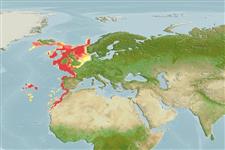Common names from other countries
Environment: milieu / climate zone / depth range / distribution range
Ecologia
; intervalo de profundidade 37 - 750 m (Ref. 356). Temperate; 71°N - 22°N, 34°W - 7°E
Eastern Atlantic: from Morocco to Atlantic coast of Europe and southern coast of Iceland.
Length at first maturity / Tamanho / Peso / Idade
Maturity: Lm 10.5, range 13 - ? cm Max length : 22.1 cm CW macho/indeterminado; (Ref. 2761); Peso máx. publicado: 1.9 kg (Ref. 2761)
Maximum carapace width: 20.0 cm (Ref. 435). Higher rate of female individuals in shallower strata, 200 to 400 m, and male individuals has a higher rate in deeper strata, 400 to 600 m. Landings of 10,000 per year (Ref. 2753). Unimodal size frequency distribution for both sexes (Ref. 2753, 2761). Occurs at depths from 37 to 700 m (Ref. 2761; 150 to 750 m in Ref. 356; 37 to 620 m in Ref. 435; and sublittoral to 700 m in Ref. 2753). Found on varied substrata (Ref. 2761). In general, species under the family Cancridae are omnivores, predators, or scavengers (Ref. 3477)
Exhibits spawning migration that results in ovigerous females occupying different territory from the rest of the population (Ref. 2753).
Fischer, W., G. Bianchi and W.B. Scott (eds.). 1981. (Ref. 435)
Categoria na Lista Vermelha da IUCN (Ref. 130435)
Categoria CITES (Ref. 108899)
Not Evaluated
Not Evaluated
Utilização humana
Pescarias: espécies comerciais
| FishSource | Sea Around Us
Ferramentas
Fontes da internet
Estimates based on models
Preferred temperature
(Ref.
115969): 6.8 - 14.1, mean 9.6 (based on 211 cells).
Resiliência
Elevada, tempo mínimo de duplicação da população menor que 15 meses (Fec=484,800).
Vulnerabilidade
Low vulnerability (10 of 100).
Categoria de preço
Unknown.
